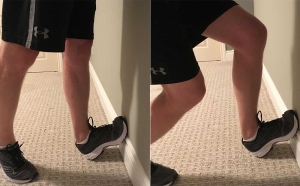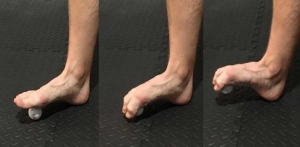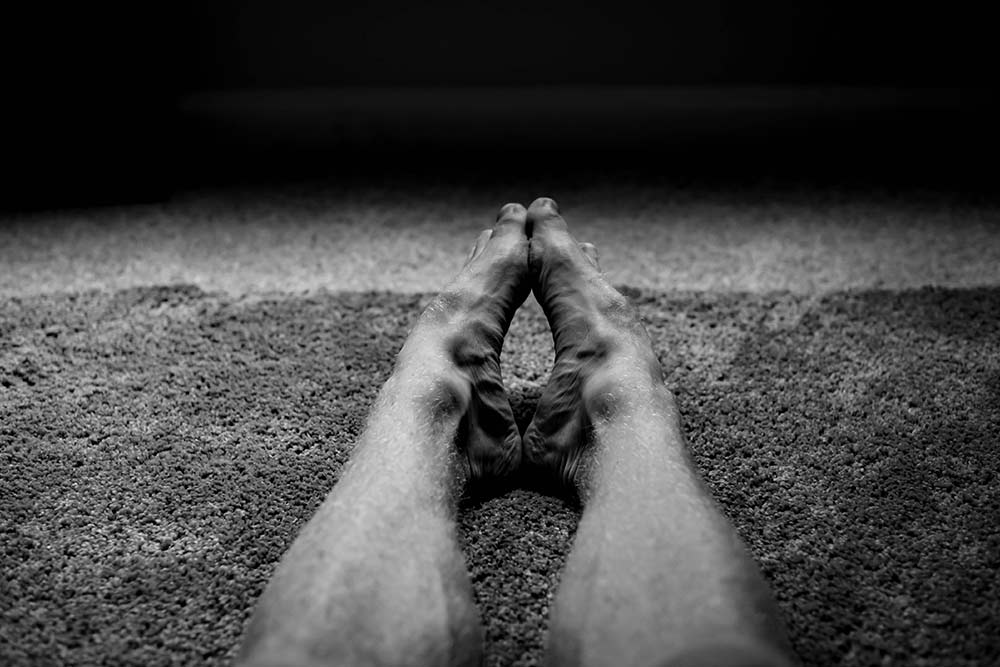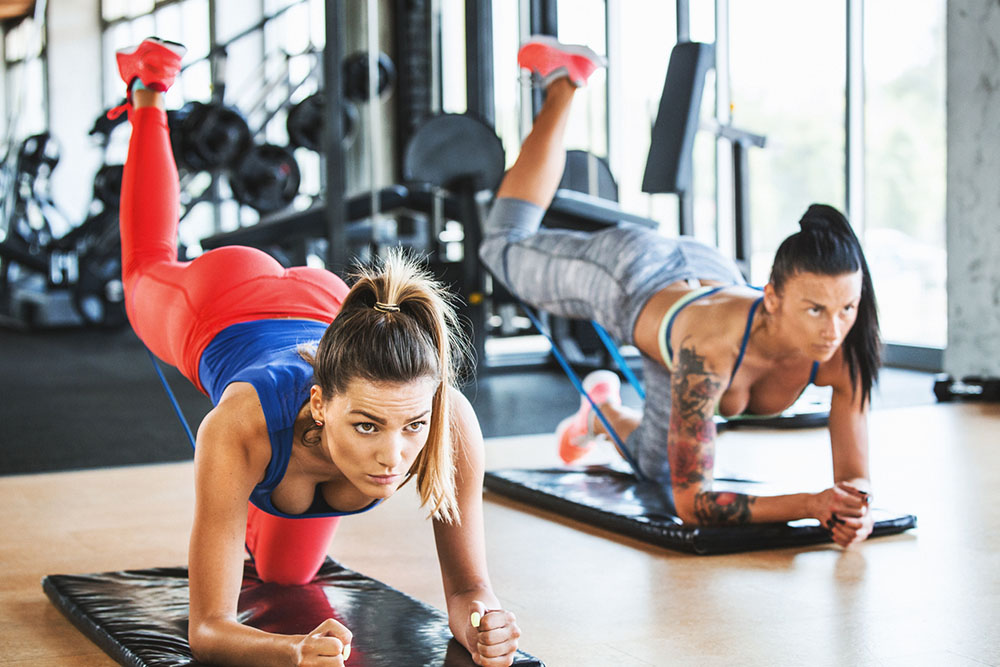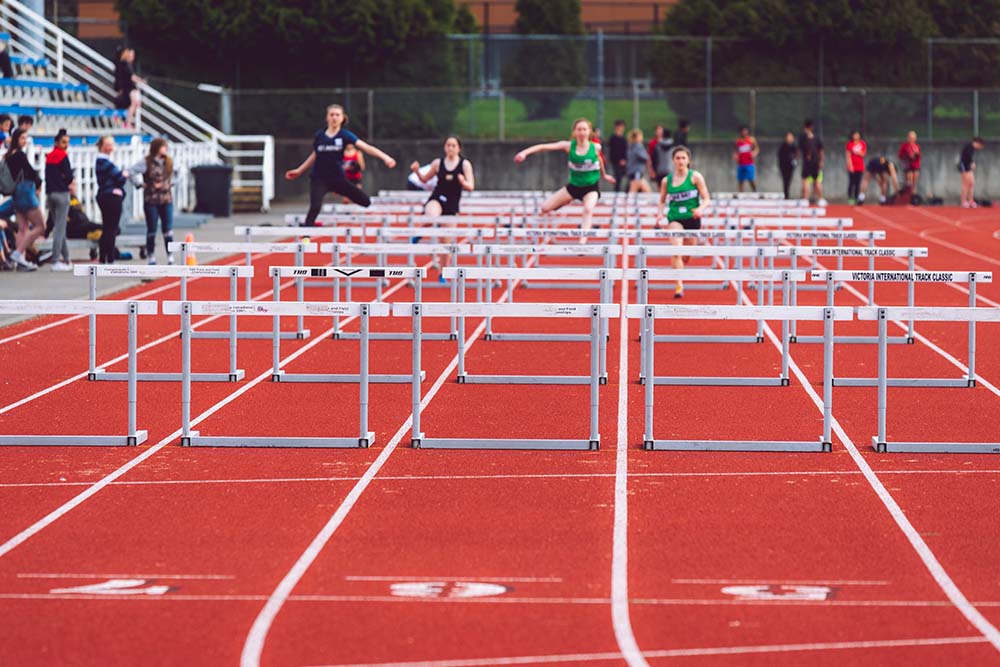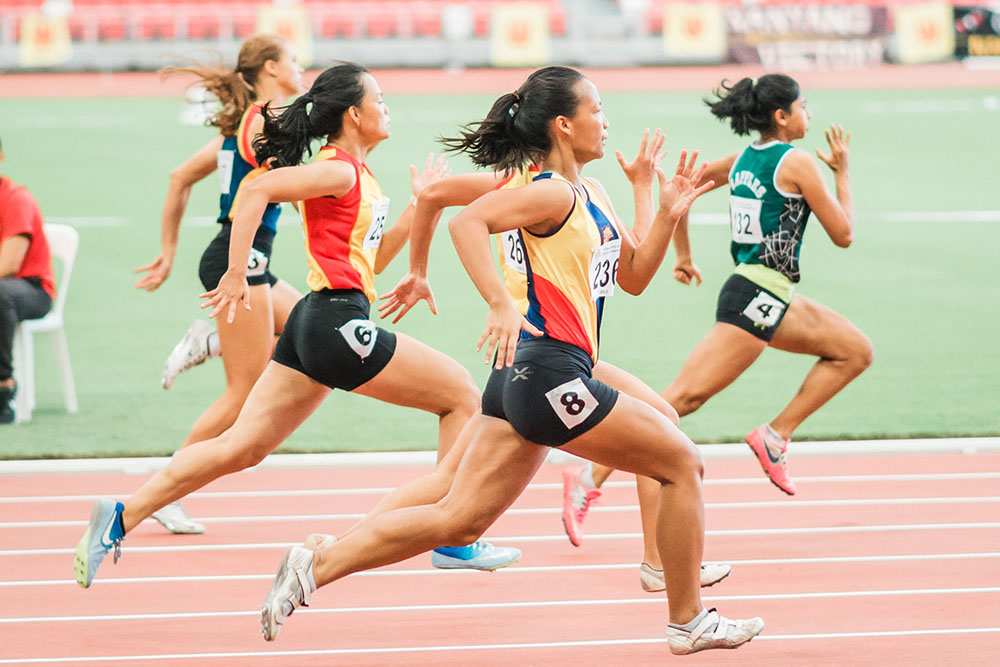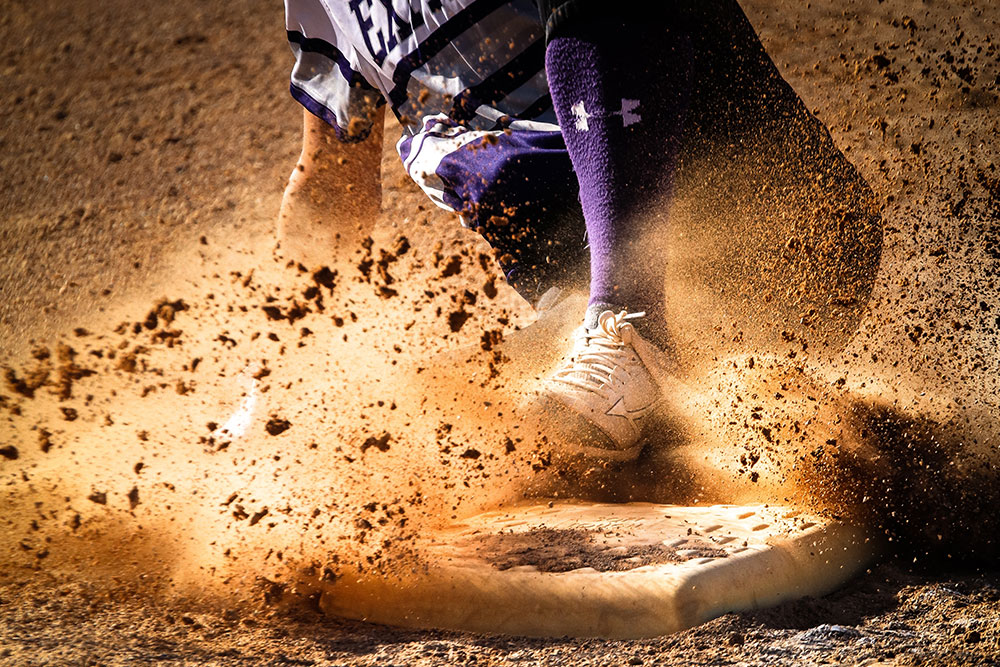How To Treat 7 Common Running Injuries

Ryan Cross, B.A. Hons (Kin), MScPT, FCAMPT
Registered Physiotherapist in Sarnia, Ontario, Canada
Running is an activity that can provide many benefits. It improves cardiovascular function, aids in weight control, and can alleviate stress. Runners don’t like to stop their running routine, even if pain or injury develops. Seeking professional help can go a long way in keeping you on your training program. Sometimes simple exercises can address pain related to running or prevent it from coming on in the first place.
Some common injuries related to running can be addressed easily with education and exercise.
1. Plantar Fasciitis
Plantar fasciitis is fancy term to describe pain on the bottom of your heel or foot. It typical involves inflammation of the plantar fascia or the tissues around the fascia. It will most commonly occur where the fascia attaches to the calcaneus (heel bone). Over time, this can lead to chronic inflammation and tissue thickening resulting in the formation of a heel spur. Plantar heel pain can sometimes develop for seemingly no reason at all, but generally occurs after an increase in standing, running, or hill climbing activities. Abnormal biomechanics of the lower extremity may also contribute to the onset of plantar fasciitis. Classic plantar fasciitis presents as extreme pain with the first few steps in the morning or after a period of rest. You will notice on the bottom of your foot, just in front of the heel, it will be very tender to touch. It is very common for people to present with decreased ankle dorsiflexion due to tight calf muscles. Increasing flexibility of the calf muscles and plantar fascia can help alleviate pain and keep you on your running program.
Calf stretch
Place your foot on the wall with your knee straight. Lean into the wall to feel the stretch on the back of your leg. To stretch all parts of the calf muscles, do the same stretch with your knee bent.
Ball Roll
To improve flexibility in the muscles of the foot and plantar fascia, roll a golf ball (or lacrosse ball) along the bottom of your foot. This condition is usually painful and rolling the ball along the bottom of your foot may cause some pain. Putting golf balls in the freezer overnight before rolling your foot can make this exercise feel better. To build strength in the muscles of the foot, pick the ball up with your foot.
Related Article: Does Movement Therapy Prevent Running Injuries
2. Achilles Tendonitis
Achilles tendonitis involves inflammation of the Achilles tendon itself, its insertion, or the paratendonous sheath. Persistent inflammation leads to thickening of the tendon, hypervascularity, nodule formation, and potential partial or full rupture. Achilles tendonitis commonly develops due to repetitive over use (running or jumping), training error, or abnormal biomechanics in the lower extremity. It can be identified by tenderness to the touch, swelling, and thickening of the tendon. Repeated plantar flexion or heel raises will usually bring on the pain, along with stretching of the tendon. Treatment will depend on how painful and acute the injury is, you may need to start with isometric contractions or light resistive band exercises to load the tendon. Tendon injuries respond well to gradual and progressive loading. If the condition is chronic and the tendon can tolerate an increased load, eccentric heel drops can help strengthen the tendon. Eccentric contractions tend to target the tendon unit of the muscle. Additionally, strengthening other components of the posterior chain can provide assistance in push off movements to the healing Achilles tendon.
Eccentric Heel Drops
Stand on your good foot. Lift on to your toes. Shift your weight onto the sore foot. Lower your weight down. Repeat 3 sets of 15
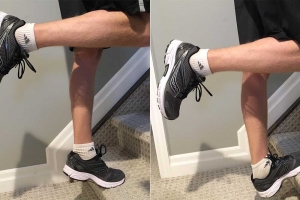
Single Leg Bridge
Get a yoga mat, then lie on your back with one knee bent and the other leg straight and off the floor. Lift your hips off the floor. Hold for 10 seconds, 10 times, 3 sets.
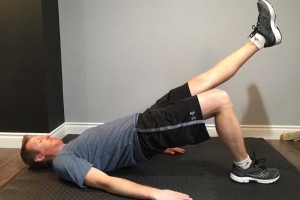
3. Patello-Femoral Pain Syndrome
Patello-Femoral Pain Syndrome (PFPS) is another generalized term that basically means “knee pain.” There are many possible sources of pain, but most are usually a result of how the patella (knee cap) is tracking as the knee moves from bending to straightening. Improper tracking of the patella can cause stress on the subchondral bone, fibrosis of the retinaculum that surrounds the patella, irritation of the infrapatellar fat pad, and tendonitis. There are many possible causes of the improper tracking including lower extremity biomechanical abnormalities, impaired motor control, and most commonly due to a muscle imbalance of strength and flexibility. Muscle imbalances involve some muscles being weak and others being tight. Muscles that are commonly found to be weak are the quadriceps (specifically vastus medialis) and the gluteus medius/minimus group. Poor flexibility of the hamstring, gastrocnemius/soleus, IT band, and hip flexors will contribute to the muscle imbalance. To rectify the muscles imbalance, an important place to start is to strengthen the quadriceps and gluteal muscle groups.
Banded Wall Squat
Lean against the wall with a resistance band tied around your knees. Slide down the wall and push your knees out against the band to keep your knee in line with your 3rd toe. Hold this position for 10 seconds, 10 times, 3 sets.
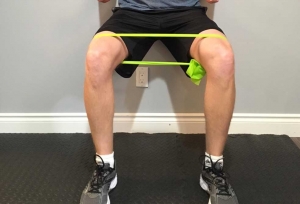
Standing Hip Abduction/Extension
Tie the band around your ankles. Stand on one foot and move the opposite leg out to the side. Try not to lean and keep your stance leg in good alignment. Repeat 15 reps, 3 sets on both legs.

Related Article: When You Should Go See A Physical Therapist
4. Patellar Tendonitis
Patellar tendonitis presents similarly to PFPS, but the pain is specific to the patella tendon located on the front of the knee just below the knee cap. It is usually brought on by repetitive jumping, sprinting, and running. These activities can place increased stress on this tendon, especially if there is a muscle imbalance in the lower extremity or poor patellar mobility. To address patellar tendonitis, eccentric step down off a step can help to target the tendon unit. The step back crossover lunge will also benefit this condition due to the co-contraction and coordination of the quadriceps, hamstrings, and gluteal muscle groups.
Eccentric Step Down
Standing on the sore leg, lower your body down to the floor. Step back up with your good leg. Repeat 15 times, 3 sets.
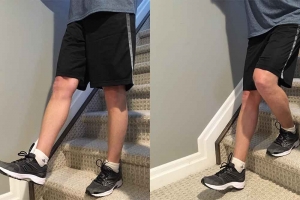
Step Back Crossover Lunge
Step back and move your leg across the body and then perform a squat in this crossover lunge position. Return to the starting position. Repeat 15 reps, 3 sets.
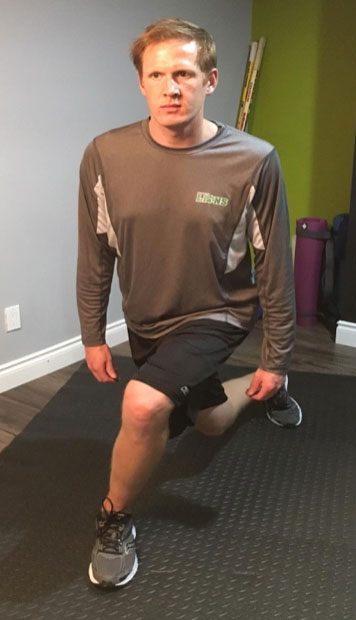
5. IT Band Syndrome
The iliotibial band (IT Band) extends from the hip to the knee. If this structure becomes tight or the muscles that attach to the band get tight, it can cause compression around the outside part of the knee. This condition can present very similar to the PFPS and patellar tendonitis, but in this case, the pain is very specific to the lateral part of the knee. Patients with IT band Syndrome will typically present with tightness of the hip flexors and weakness of the gluteus medius muscle. They will also complain of tenderness along the outside part of the thigh. Treatment will consist of foam rolling to help break down tightness and trigger points in muscles of the thigh and strengthening of the gluteus medius muscle.
Closed Chain Hip Abduction
Since the pain usually comes on during running and closed chain activities, it is important to train the muscle in a similar manner. Stand beside wall with a stability ball between you and the wall. Push you hip into the ball and slowly slide down the wall. Hold at the bottom for 10 seconds, 10 times, 3 sets.
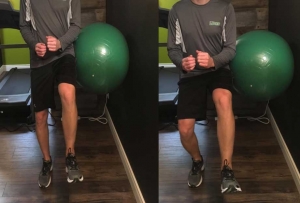
Foam Rolling
Lie on your side with the roll under your hip and roll slowly down toward your knee and back up to your hip 5-10 times.
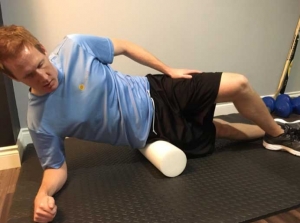
Related Article: Reduce Muscle Fatigue With Foam Rolling
6. Greater Trochanteric Bursitis
The greater trochanteric bursa of the hip is located on the outside part of hip and can felt beside a bony bump. A bursa is located here to reduce friction of the muscles that cross over this bony bump. Bursitis involves inflammation of the bursa, typically due to over use. Tightness of the hip flexor muscles can also contribute to irritation and inflammation of this bursa. Pain is usually felt as a dull constant ache in the upper lateral aspect of the hip that is worse with repetitive activity (walking, running, climbing stairs). It is also tender to touch and pain is increased if rolling on to that side. Improving hip flexor flexibility and lateral hip and core strength can help alleviate symptoms.
Related Article: It’s All In The Hips
Hip Flexor Stretch
In the kneeling position, roll your hips back (posterior tilt) and push your hip forward to feel the stretch on the front of your hip. Hold for 30 seconds, 3 times, 3 sets.

Side Plank with Leg Lift
From the side plank position, lift your leg up into the air. Maintain good pelvic position as your lift your leg. Hold 10 seconds, 10 times, 3 sets.
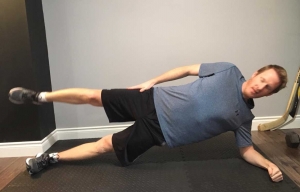
7. Low Back Pain
Low back pain can also develop as a result of a running training program. The reasons for low back pain are rarely straight forward as there are a number of factors that can lead to back pain. Limitations across the lower extremity can contribute to the development of low back pain. Decreased ankle dorsiflexion, weak gluteal muscle strength, decreased hip extension and poor core muscle control can all alter your running technique and place adverse strain on the lumbar spine. Sometimes simple exercises can be done to address these limitations. Other times taking time to video tape your running technique or taking a lesson from a professional can go a long way to prevent injury. Weight control is another important consideration that can minimize and prevent low back pain when beginning a running program. Full lumbar mobility and strength of the muscles that support the spine is also important to eliminate and prevent low back pain.
Lumbar Mobility
Lie on your stomach and press yourself up. Keep your hips on the floor and your elbows fully extended. Lower yourself down to the floor and then press yourself up and back so you are resting on your heels. This moves your spine through its full range of flexion and extension.
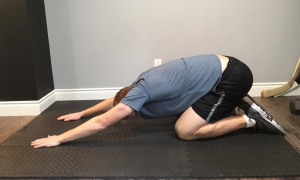
Front plank
Support yourself on your elbows and toes. Keep your back straight. Hold position for 20 seconds, 4 times.
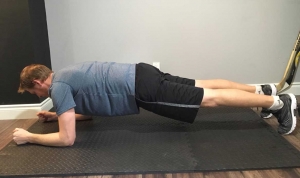
Running is a great activity to participate in for many reasons. Although there is a risk of injury, simple exercises can address some common injuries. The common theme of injury prevention and recovery is the need to address the entire lower extremity. Limitations along the lower kinetic chain can impact your ability to complete your running program. When running causes pain, try these simple exercises to keep you going. If the pain persists, go see your physical therapist to get you back on track!
Related Article: 4 Stages Of Core Training For Lower Back Pain
You Might Like:

